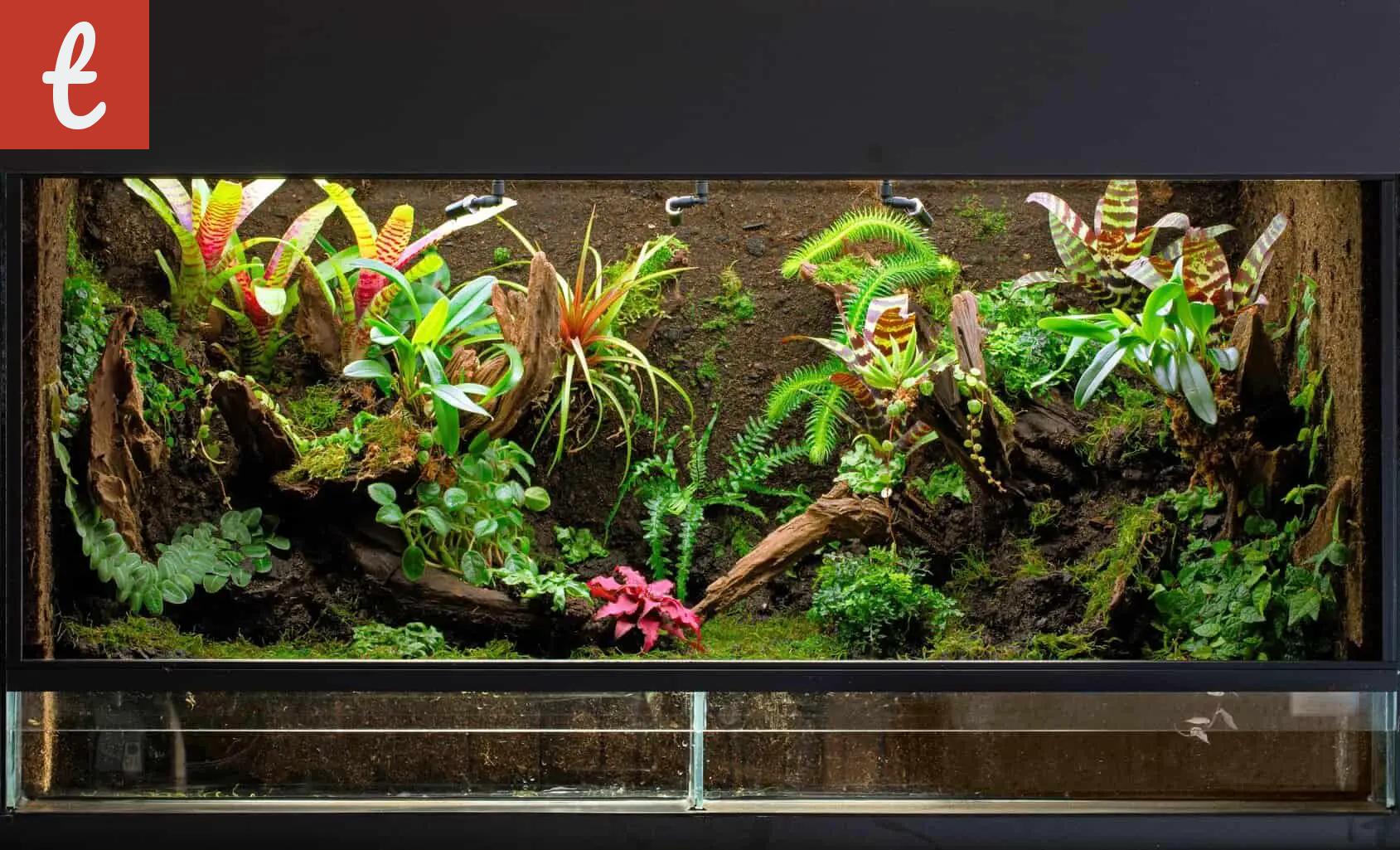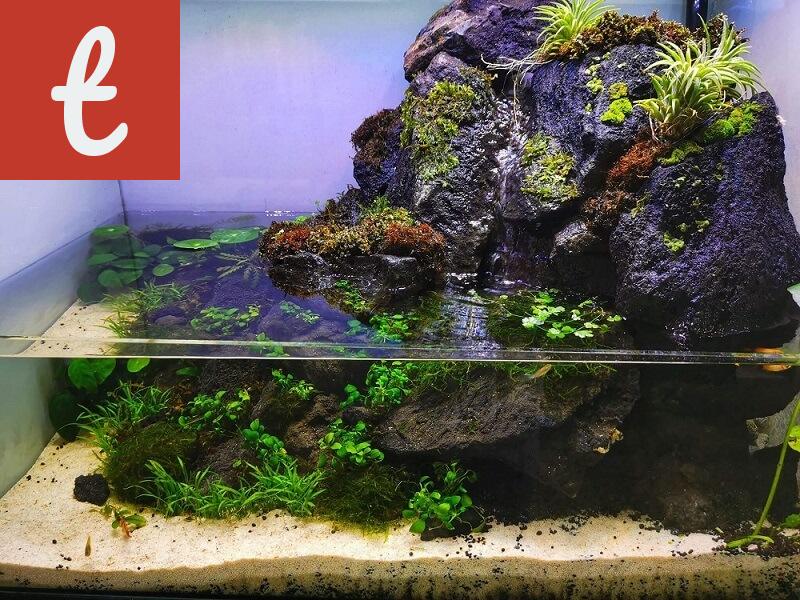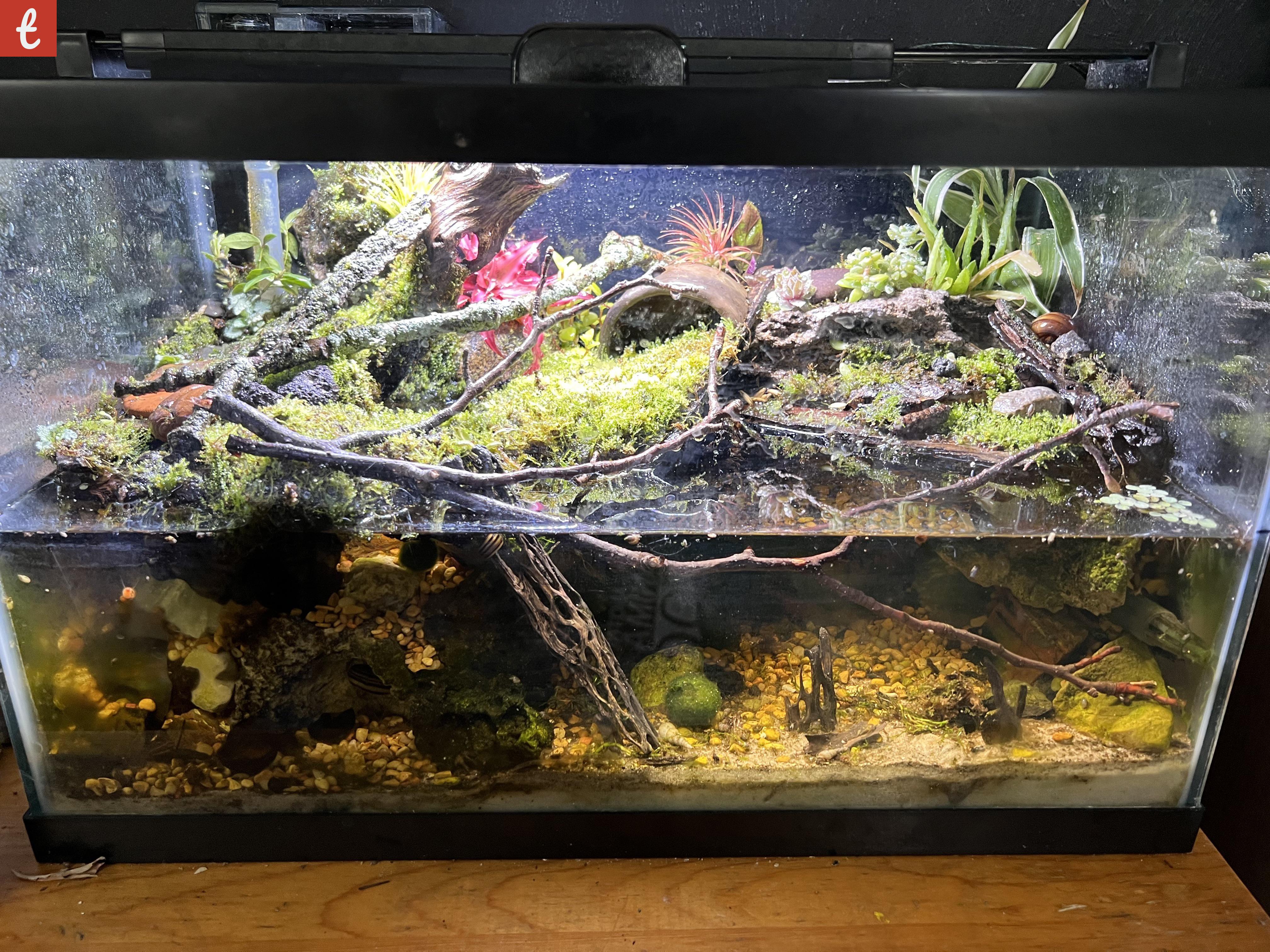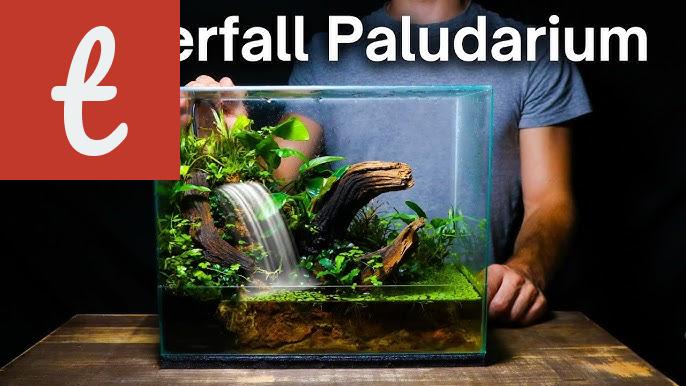Main Title
Are you someone who loves nature and wants to bring a little piece of it indoors? A paludarium might be the perfect solution for you. A paludarium is a type of vivarium that combines both terrestrial and aquatic elements, creating a miniature ecosystem. With the right design and space-saving techniques, you can create a beautiful small paludarium that fits perfectly in your home or office.
When it comes to designing a small paludarium, there are a few key techniques that can help you maximize space while still creating a stunning display. Here are some tips to get you started:
- Choose the Right Plants: Selecting the right plants is crucial for a small paludarium. Look for plants that are well-suited for both aquatic and terrestrial habitats. Some examples include mosses, ferns, and small tropical plants. These plants not only add beauty to your paludarium but also help create a natural look and feel.
- Utilize Vertical Space: When working with a small paludarium, it's essential to make the most of vertical space. Incorporating hanging plants or installing floating shelves can provide extra room for your plants and create a visually appealing display. Additionally, using tall or climbing plants can add depth and make your paludarium seem larger.
Another space-saving technique is to use arrangements that combine both terrestrial and aquatic elements within the same area. This not only helps you make the most of limited space but also creates an intriguing visual contrast. For example, consider adding a small stream or waterfall that flows from a higher terrestrial area into a lower aquatic area. This feature adds both visual interest and functionality to your paludarium.
Finally, proper lighting is crucial for a small paludarium. Choose lights that are specifically designed for use in aquariums or terrariums. These lights provide the right spectrum of light for your plants to thrive. Additionally, you can use LED lights to save space and energy while still ensuring your plants receive adequate lighting.
In conclusion, designing a small paludarium doesn't have to be a daunting task. By implementing these space-saving techniques, you can create a beautiful and functional miniature ecosystem that fits perfectly in your home or office. Remember to select the right plants, make use of vertical space, incorporate both terrestrial and aquatic elements, and invest in proper lighting. With a little creativity and planning, you can enjoy the beauty of nature in a small space.
Creative Ideas for Designing a Compact Paludarium
Are you a nature enthusiast looking to bring a piece of the wild indoors? If so, designing a compact paludarium might be just the project for you! A paludarium is a unique type of vivarium that incorporates both a terrestrial area for plants and an aquatic area for aquatic plants, animals, or even fish. This miniature ecosystem not only adds beauty to your space but also offers a unique opportunity to observe and learn more about nature. In this article, we will explore some creative ideas for designing a compact paludarium that will captivate your senses and help you create a stunning natural display.
Before we dive into the design ideas, let's first consider the basic requirements of a compact paludarium. It should have a suitable enclosure, adequate lighting, a controlled temperature and humidity level, and the right selection of plants and animals. Once you have these essentials in place, you can let your creativity soar.
- 1. Jungle Paradise: Transform your compact paludarium into a lush jungle landscape. Use a variety of hanging plants, mosses, and vines to create layers of greenery. Incorporate small tree branches or driftwood to mimic the natural habitat of tropical rainforests.
- 2. Aquatic Wonder: Make the aquatic portion of your paludarium the focal point. Choose vibrant aquatic plants like Java fern, Anubias, or water lilies to create an underwater paradise. Add rocks, pebbles, or sand to the bottom to create a natural-looking aquatic environment.
- 3. Desert Oasis: Create a striking contrast by designing a desert-themed paludarium. Use succulents, cacti, and sand to mimic a desert landscape. To add an interesting twist, you can create a small oasis with a miniature pond or waterfall.
- 4. Moss Forest: If you prefer a more subtle and serene design, consider creating a paludarium with a dense moss forest. Mosses are relatively easy to care for and can thrive in a high humidity environment. Add small figurines, rocks, or a mini waterfall to create a magical atmosphere.
- 5. Coastal Retreat: Bring the coastal beauty into your living room with a paludarium inspired by the ocean. Incorporate aquatic plants such as sea grass or marine algae. Use seashells, rocks, and miniature figurines to complete the coastal look.
Remember to maintain a balance between the terrestrial and aquatic elements in your compact paludarium. Ensure that plants and animals within the enclosure have enough space to grow and thrive. Regular maintenance is also crucial to prevent any imbalance in the ecosystem.
In conclusion, designing a compact paludarium allows you to create a mesmerizing miniature world right in your own home. Whether you opt for a jungle paradise, an aquatic wonderland, a desert oasis, a mossy forest, or a coastal retreat, let your imagination guide you. Explore different plant and animal combinations, experiment with different lighting setups, and watch as your compact paludarium transforms into a captivating piece of living art.
Miniature Paludarium Design Tips for Small Spaces
Creating a miniature paludarium in a small space can be a fun and rewarding project for any nature enthusiast. Paludariums are unique vivariums that combine terrestrial and aquatic habitats, allowing you to create a mini ecosystem that resembles a small rainforest. Whether you have limited space in your apartment or just want to add a touch of nature to your office, here are some design tips to help you get started.
1. Choose the right container: When designing a miniature paludarium, it's important to choose a container that suits your space. Look for a glass or acrylic enclosure that is flat and has enough surface area to accommodate both the terrestrial and aquatic components. A cube or rectangular-shaped container works best for small spaces.
2. Plan your layout: Before adding any plants or animals, plan your layout carefully. Decide how much space you want to dedicate to the aquatic and terrestrial sections. Consider the size and number of plants you want to include, as well as the amount of water you want to keep. A balanced distribution of elements is key to creating a visually appealing paludarium.
3. Create a water feature: One of the highlights of a paludarium is the water feature. Build a small waterfall or a flowing stream using a small water pump and some rocks. Incorporate aquatic plants and even small fish or shrimp to create a vibrant underwater scene. The sound of running water will not only add serenity to your space but will also help in maintaining humidity levels within the enclosure.
4. Select compatible plants and animals: Choose plants and animals that are compatible with each other in terms of light, temperature, and humidity requirements. Small tropical plants like mosses, ferns, and bromeliads are great choices for the terrestrial section. In the water, consider adding aquatic plants like java fern or water lettuce. When it comes to animals, small amphibians, such as dart frogs or newts, can thrive in the paludarium environment.
- 5. Stick to a regular maintenance routine: Just like any other vivarium, paludariums require maintenance. Monitor the temperature and humidity levels regularly, and make adjustments as needed. Keep the water clean and provide regular water changes to prevent the build-up of harmful toxins. Trim and prune plants to maintain a balance between the terrestrial and aquatic sections.
- 6. Incorporate proper lighting: Good lighting is essential for the health of both plants and animals in a paludarium. Depending on the types of plants you have, choose appropriate lighting options such as fluorescent lights or LED grow lights. Consider using timers to simulate day and night cycles, ensuring the well-being of both flora and fauna.
Creating a mini rainforest in a small space can be a delightful experience. It provides a natural escape and brings a calming ambiance to any environment. With careful planning and attention to detail, your miniature paludarium will become a unique display of nature's beauty.

How to Create a Tiny Paludarium with Maximum Impact
If you're a nature lover and want to bring a slice of the wild into your home, creating a paludarium might be the perfect solution. A paludarium is a unique combination of both an aquarium and a terrarium, creating an aquatic environment with lush plants and small land areas. While it may seem daunting at first, creating a tiny paludarium can be a fun and rewarding project that will bring a touch of nature indoors.
Keywords: paludarium, tiny paludarium
Here are some steps to guide you in creating a tiny paludarium with maximum impact:
- Research and Planning: Before you start, it's crucial to do some research and planning. Look into the different types of plants and aquatic creatures that thrive in paludarium environments. You'll want to consider the size of your tank, lighting requirements, water parameters, and the types of animals and plants that will coexist harmoniously.
- Choosing the Perfect Tank: For a tiny paludarium, you don't need a large tank. Aim for a tank size that suits the available space in your home. A small aquarium with dimensions around 10-20 gallons should work well. Make sure the tank has a tight-fitting lid to maintain proper humidity levels.
- Creating the Aquatic Environment: Begin by adding a layer of substrate at the bottom of your tank. You can choose from various options such as aquarium soil or specialized paludarium substrate. Then, fill the tank with water, ensuring that the depth is suitable for the aquatic plants and creatures you have chosen. Install a small filter to maintain water quality.
- Integrating the Land Area: In a tiny paludarium, space for a land area may be limited. However, you can create an elevated section using rocks or driftwood. Secure the materials carefully to avoid collapsing or shifting. Add a layer of substrate suitable for planting small terrestrial plants.
- Choosing the Right Plants and Animals: Select plants that can tolerate both water and land environments. Mosses, ferns, and small tropical plants like Fittonia or Cryptanthus are great options. For animals, consider tiny frogs, snails, or small fish like colorful guppies or endlers. Research their compatibility with the chosen plants and ensure they can thrive in a compact ecosystem.
- Lighting and Temperature Control: Proper lighting is vital for the growth of both aquatic and terrestrial plants. LED lights with adjustable settings are highly recommended. Additionally, monitor the temperature within the paludarium to maintain optimal conditions for the plants and animals you have selected.
- Maintenance and Care: Regular maintenance is crucial for the health of your paludarium. Monitor water parameters, perform regular water changes, and prune plants to prevent overgrowth. Keep an eye out for any signs of stress or disease among your animals and seek appropriate solutions.
In conclusion, creating a tiny paludarium can bring the beauty of nature into your home without taking up too much space. With proper planning, careful selection of plants and animals, and dedicated maintenance, you can achieve a stunning and impactful miniature ecosystem. Start small and watch your tiny paludarium flourish!
Designing a Small Paludarium: Tips and Tricks
Are you an avid nature lover who wants to bring the beauty of both land and water into your living space? Consider creating a small paludarium, which is a combination of a terrarium and an aquarium. This mini ecosystem can be a stunning addition to your home or office, while providing a suitable environment for plants and aquatic species to coexist. In this article, we will discuss some useful tips and tricks to help you design your own small paludarium.
First and foremost, it's important to carefully select the right container for your paludarium. Opt for a tank that is large enough to accommodate the plants and animals you intend to keep, taking into consideration their growth and spatial requirements. Ensure the tank has a secure lid to maintain proper humidity levels and prevent any potential escapes.
- Choose the ideal location for your paludarium. Consider factors such as natural light availability, room temperature, and proximity to electrical outlets. Strike a balance between providing enough light for your plants and preventing excessive heat buildup.
- Plan the layout of your paludarium. You may choose to create a sloping terrain by using rocks and driftwood to mimic a natural environment. This allows for different water levels and creates interesting land and water interfaces for your fauna and flora.
When choosing plants for your paludarium, opt for varieties that thrive in both submerged and terrestrial conditions. Mosses, ferns, and bromeliads are excellent choices as they can tolerate the humid environment and adapt well to such setups. Ensure you research the specific requirements and growth patterns of each plant before adding them to your paludarium.
Now it's time to select the right aquatic species for your paludarium. Consider small fish species like guppies or endlers, as they can thrive in the limited water space. Additionally, aquatic invertebrates such as shrimp and snails can add visual interest to the tank. Always ensure that the species you choose are compatible with the plants and other inhabitants of your paludarium.
Regular maintenance is key to keeping your paludarium healthy and thriving. Ensure proper lighting and humidity levels are maintained, and monitor the water quality to prevent any issues. Keep an eye out for any overgrown plants or potential overcrowding of aquatic species, and make necessary adjustments as needed.
In conclusion, designing a small paludarium can be a rewarding endeavor for nature enthusiasts. With careful planning and consideration, you can create a captivating mini ecosystem that combines the beauty of land and water. Remember to choose the right container, select suitable plants and aquatic species, and maintain regular upkeep. Enjoy the process of creating your very own small paludarium!




Comments on "Tips For Designing The Smallest Paludarium"
No comment found!